The Mathematica command N[Pi,31] produces:
3.1415926535897932384626433832795
If you only ask for N[Pi,30], you get:
3.14159265358979323846264338328
This isn't exactly wrong, but it's only 29 decimal places, since the "0" in the 30th place doesn't get printed.
Point: It's a good idea to apply common sense
to answers Mathematica gives you.
2. [1 point] Find the equation of the line tangent to f(x) = e-x
sin x where x = 1.
Mathematica computes the derivative to
be ![]() ,
but the rest is more easily done by hand. The equation of the tangent line
is y -
,
but the rest is more easily done by hand. The equation of the tangent line
is y - ![]() =
= ![]() (x-1).
(x-1).
Point: Some things it's easier to have Mathematica do, other things it's easier to do yourself.
Other Point: Don't make things hard on yourself.
Leaving that line in the form given here is lots less work than most of
you did, and pretty much just as useful -- with less chance to screw up
while simplifying.
3. [1 point] Find the value of the ugliest integral (your choice) from
problems 9-60 in the chapter 7 review.
Obviously this depends on which one you pick. Personally, I think they're all very pretty and resent the insinuation that any of them are esthetically lacking in any way.
Point: Even the messiest problems aren't very
hard for Mathematica, and our job mostly boils down to figuring
out how to ask 'em.
4. [1 point] Look at the graphs of y = sin2
x and y = sin 2x. Which one is the derivative of the other?
If we plot the graphs of the two functions on the same set of axes, it's easy to see that where sin2 x (shown in blue) has a horizontal tangent, and hence a zero derivative, sin 2x (shown in blue) has a height of zero. Likewise where the blue graph slopes up the red graph's height is positive, and vice versa for down. Thus sin2 x seems to be the derivative of sin 2x.
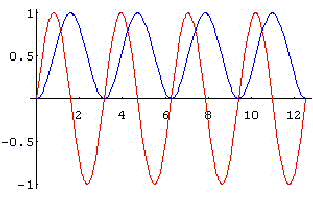
Point: It's a problem that you can almost answer
as easily with a graphing calculator, but Mathematica (used properly)
sure makes it pretty, and thus maybe easier to get across to someone else.
5. [1 point] Consider the surface f(x,y) = cos ![]() .
The surface doesn't have just one high point, but lots of them -- describe
(in comprehensible english) the set of points where f takes on global maximum
values.
.
The surface doesn't have just one high point, but lots of them -- describe
(in comprehensible english) the set of points where f takes on global maximum
values.
A good view of the graph can be generated with the Mathematica command:
Plot3D[Cos[Sqrt[x^2+y^2]],{x,-4Pi,4Pi},{y,-4Pi,4Pi},PlotPoints->40,Mesh->False]
which produces:
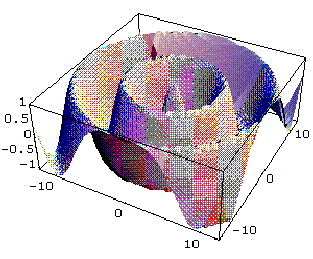
Either looking closely at the graph, or carefully
considering the formula and the periodicity of cosine, tells you that the
peaks will have a height of 1 and will happen on concentric circles around
the origin with radii that are multiples of 2![]() .
.
Point: First, it's an important example to have
in mind -- functions of two variables often don't have single peaks. Second,
it's an exercise in communication -- it's not easy to describe where those
peaks happen, and probably much clearer to do it in English rather than
fancy notation. Third, it was supposed to be good practice chosing good
viewing domains before getting on to the tougher problems -- and some of
you made good on that while others didn't.
6.[1 point] You're a drop of water at the point
(![]() /3,0,1/2) on the
surface z = cos x cos y. Where do you end up? Describe (in some reasonably
precise way) the region from which other drops of water will tend toward
the same spot.
/3,0,1/2) on the
surface z = cos x cos y. Where do you end up? Describe (in some reasonably
precise way) the region from which other drops of water will tend toward
the same spot.
The Mathematica commands:
surface = Plot3D[Cos[x]Cos[y],{x,-2Pi,2Pi},{y,-2Pi,2Pi},PlotPoints->25,Mesh->False]
and:
drop = Graphics3D[Point[{Pi/3,0,1/2}]]
followed by:
Show[surface,drop]
produce the picture:
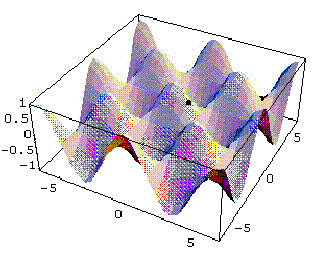
A little imagination suggests that the drop will
roll downhill to (![]() ,
0, -1).
,
0, -1).
For the question of which other points will "drain"
to this same place, either some good visualization or a contour plot like
that shown below suggests that the square with corners (0,0), (![]() ,
, ![]() ),
(2
),
(2![]() , 0), and (-
, 0), and (-![]() ,
, ![]() )
surrounds this "drainage basin".
)
surrounds this "drainage basin".
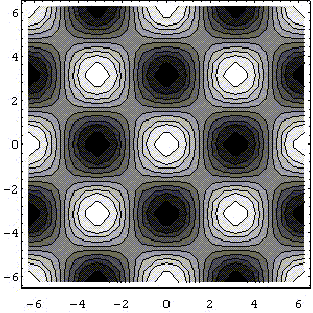
7. [2 points] Get Mathematica to plot
a sphere of radius 5 centered at the origin. Explain how
you did it (you might include a printed copy
of your work if you think it will help).
There are a variety of ways to accomplish this, most with drawbacks of one sort or another. A very good way to do it, if you remember your parametric equations from chapter 11 well, is:
ParametricPlot3D[{Sin[u] Cos[v], Sin[u] Sin[v], Cos[u]}, {u,0,Pi}, {v,0,2Pi}]
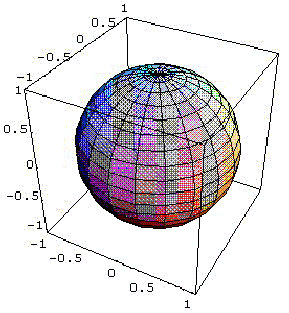
8. [2 points] Consider the function f(n) =  .
Compute f(1), f(2), f(3), f(4), (at least) and describe the pattern.
.
Compute f(1), f(2), f(3), f(4), (at least) and describe the pattern.
Mathematica makes evaluating these integrals very quick, and the pattern becomes clear. I was happy whether you described it as n! or in what's called a "recursive" form as f(n) = n f(n-1), although it should be noted that the recursive rule alone doesn't specify a unique function -- you have to also know a starting value, in this case that f(1) = 1.
Point: First, that Mathematica makes otherwise
hard integrals quick. Second, did you ever wonder about the "in-between"
factorials? What happens to 1.5!, and so forth?
9. [3 points] Do problem #70 from section 12.1.
Explain clearly what different shapes are possible depending on the values
of a and b.
Here are several particular graphs that illustrate most of the particular cases that can happen. Note that the choice of domain makes a big difference in how well you can tell what the graph really looks like.
a=1, b=1:
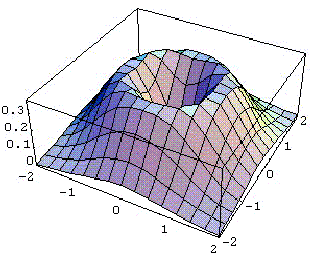
a=3, b=3 (notice the scales):
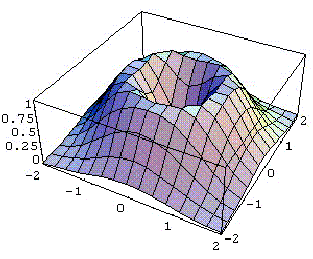
a=1, b=3:
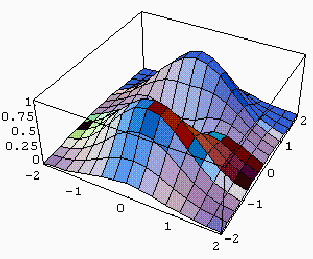
a=0, b=3:
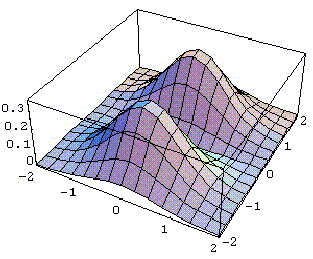
a=1, b=-3:
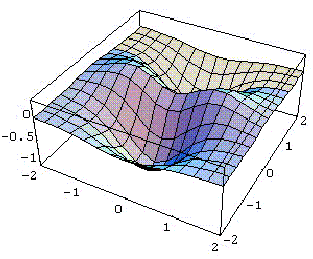
a=-2, b=-2:
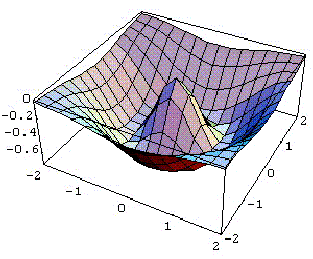
About the best descriptions of the basic forms are "a volcano" and "a crater with a bump in the middle". The value of a determines the height of the bump along the x-axis, whether positive, zero, or negative, and similarly b determines the bump along the y-axis. Further out, as the distance from the origin increases the height of the surface tends quickly toward zero (in contrast to a paraboloid, for instance).
Point: Try some different domains before jumping
to conclusions, because with the wrong perspective graphs can be more distorting
than illuminating. Also make sure you've considered all the possibilities
-- just trying positive values, for instance, doesn't really give a complete
picture.
10. [2 points] Find something Mathematica
can't do.
Tie my shoes, fix a good Bacardi & Coke, explain
to me things I don't understand, etc.